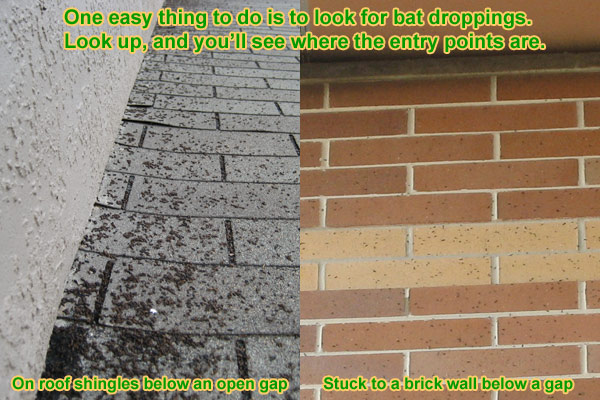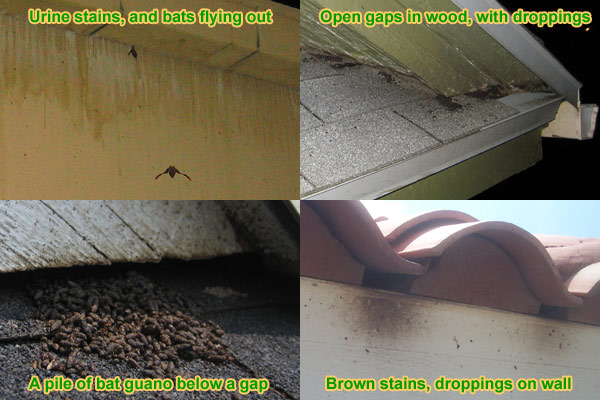How To Inspect Your Home For Bat Evidence And Bat Entry Points - Do you suspect that bats have invaded your home because you hear scratching in the walls or attic, or because you smell the odor of their guano? It is vital that you thoroughly check every inch of your home for evidence of the presence of bats and for their entry points into your home. Bats can enter your home in a crack or opening as small as 3/8 of an inch, so it is understandably easy to miss their entry points. You will need to be patient and thorough with your search.

Search For Guano
One of the easiest ways to check for the presence of bats and to find their entry point is to look for guano (bat droppings). It may be on the ground below the entry point, or it may be on the wall under the entry point. If you can locate a large amount of guano in a particular area, it is likely to be near the entry point and not just droppings left as the bats are flying around. If you can access your roof, check around the perimeters, especially in open corners. You can also go up in your attic and check for the presence or the smell of guano. If the guano is there, the bats are there, or they have been there. If they have migrated, you can be certain that they will return unless you can seal off their entry point.

Outside Walls
If you don’t have access to your attic, or you don’t see any guano, there are other ways to check for the presence of bats and to find their entry point. You can check the outside walls of your home and your roof for urine stains from the bats, which would indicate an entry point. You can also look for brown stains that come from the oil on the bats’ skin as they squeeze in through their entry point. Another way to check for evidence of bats and to find their entry point is to essentially stake out your house at dusk and watch for them to fly out. You should have a few people to help you so that you can cover each corner of the house. At dusk, when the bats fly out, you will be able to see where they are coming from, and you can narrow your search.

Checking The Suspected Entry Point
If you see the bats fly out of the house, or you find guano, urine, or oil stains, you can begin your in-depth search for the entry point. Roof vents, gables, and ridge caps are common points of entry for bats, so check those first. If you don’t see any evidence of bats there, then you need to examine closely the exterior of your home for damage that might be entry points for the bats. If your siding is warped, it could be causing a gap for the bats to enter through. Missing bricks or broken windows are other potential entry points. Any louvers or vents in your siding could be entry points as well. Because bats can squeeze through very small openings, you will have to be very diligent in your search for entry points. If you still can’t find the entry point, you can try placing a bright light inside of the attic or roosting area at night, and then go outside and look for signs of the light that indicate a gap or crack. If you still can’t find the entry point, you can put on a protective mask and clothing and sit in the bat roosting area and wait for the bats to return.

Get in the Attic
An inspection inside the attic is very helpful. You'll see where the bat droppings are concentrated, and often see clusters of bats clinging to or climbing down the walls as you approach. This can give you some clues as to where they are entering. But in as many cases as not, you won't see them at all, because they can cluster in incredibly tight packs behind wood beams or down walls or in eaves, where you won't ever see them from inside the attic.
Removal Of Bats
If you can’t find all the entry points, you may need to enlist the help of an animal removal expert. Bats can cause illnesses, such as rabies, and histoplasmosis, a disease caused by the inhalation of fungal spores that grow in bat guano. They can also cause damage to your home, and the smell of the guano and urine is very unpleasant. If you find evidence of bats, you must have them removed. There is only one way to remove bats legally and permanently, and that is by live exclusion. This means waiting for the bats to leave the roost, and then sealing up the entry point so they cannot access your home. This can only be done during certain times of the year, such as after the bats have migrated. It is illegal to perform live exclusion during the months when there may be flightless baby bats in the roost. It is also illegal to fumigate them, trap them, or to use any other inhumane removal method. The bats will return if the entry points are not completely sealed. Take the time to inspect and insure that your home’s entry points are sealed properly to prevent the bats’ return.
HELP: If you need professional help in solving your bat problem, please click on my Hiring Advice and 2018 Directory of Bat Removal Professionals serving every city in the USA.
Go back to my main bats in the attic home page.
Wildlife Education - Information and Advice for the Safe Removal of Bats from Attics

Search For Guano
One of the easiest ways to check for the presence of bats and to find their entry point is to look for guano (bat droppings). It may be on the ground below the entry point, or it may be on the wall under the entry point. If you can locate a large amount of guano in a particular area, it is likely to be near the entry point and not just droppings left as the bats are flying around. If you can access your roof, check around the perimeters, especially in open corners. You can also go up in your attic and check for the presence or the smell of guano. If the guano is there, the bats are there, or they have been there. If they have migrated, you can be certain that they will return unless you can seal off their entry point.

Outside Walls
If you don’t have access to your attic, or you don’t see any guano, there are other ways to check for the presence of bats and to find their entry point. You can check the outside walls of your home and your roof for urine stains from the bats, which would indicate an entry point. You can also look for brown stains that come from the oil on the bats’ skin as they squeeze in through their entry point. Another way to check for evidence of bats and to find their entry point is to essentially stake out your house at dusk and watch for them to fly out. You should have a few people to help you so that you can cover each corner of the house. At dusk, when the bats fly out, you will be able to see where they are coming from, and you can narrow your search.

Checking The Suspected Entry Point
If you see the bats fly out of the house, or you find guano, urine, or oil stains, you can begin your in-depth search for the entry point. Roof vents, gables, and ridge caps are common points of entry for bats, so check those first. If you don’t see any evidence of bats there, then you need to examine closely the exterior of your home for damage that might be entry points for the bats. If your siding is warped, it could be causing a gap for the bats to enter through. Missing bricks or broken windows are other potential entry points. Any louvers or vents in your siding could be entry points as well. Because bats can squeeze through very small openings, you will have to be very diligent in your search for entry points. If you still can’t find the entry point, you can try placing a bright light inside of the attic or roosting area at night, and then go outside and look for signs of the light that indicate a gap or crack. If you still can’t find the entry point, you can put on a protective mask and clothing and sit in the bat roosting area and wait for the bats to return.

Get in the Attic
An inspection inside the attic is very helpful. You'll see where the bat droppings are concentrated, and often see clusters of bats clinging to or climbing down the walls as you approach. This can give you some clues as to where they are entering. But in as many cases as not, you won't see them at all, because they can cluster in incredibly tight packs behind wood beams or down walls or in eaves, where you won't ever see them from inside the attic.
Removal Of Bats
If you can’t find all the entry points, you may need to enlist the help of an animal removal expert. Bats can cause illnesses, such as rabies, and histoplasmosis, a disease caused by the inhalation of fungal spores that grow in bat guano. They can also cause damage to your home, and the smell of the guano and urine is very unpleasant. If you find evidence of bats, you must have them removed. There is only one way to remove bats legally and permanently, and that is by live exclusion. This means waiting for the bats to leave the roost, and then sealing up the entry point so they cannot access your home. This can only be done during certain times of the year, such as after the bats have migrated. It is illegal to perform live exclusion during the months when there may be flightless baby bats in the roost. It is also illegal to fumigate them, trap them, or to use any other inhumane removal method. The bats will return if the entry points are not completely sealed. Take the time to inspect and insure that your home’s entry points are sealed properly to prevent the bats’ return.
HELP: If you need professional help in solving your bat problem, please click on my Hiring Advice and 2018 Directory of Bat Removal Professionals serving every city in the USA.
Go back to my main bats in the attic home page.